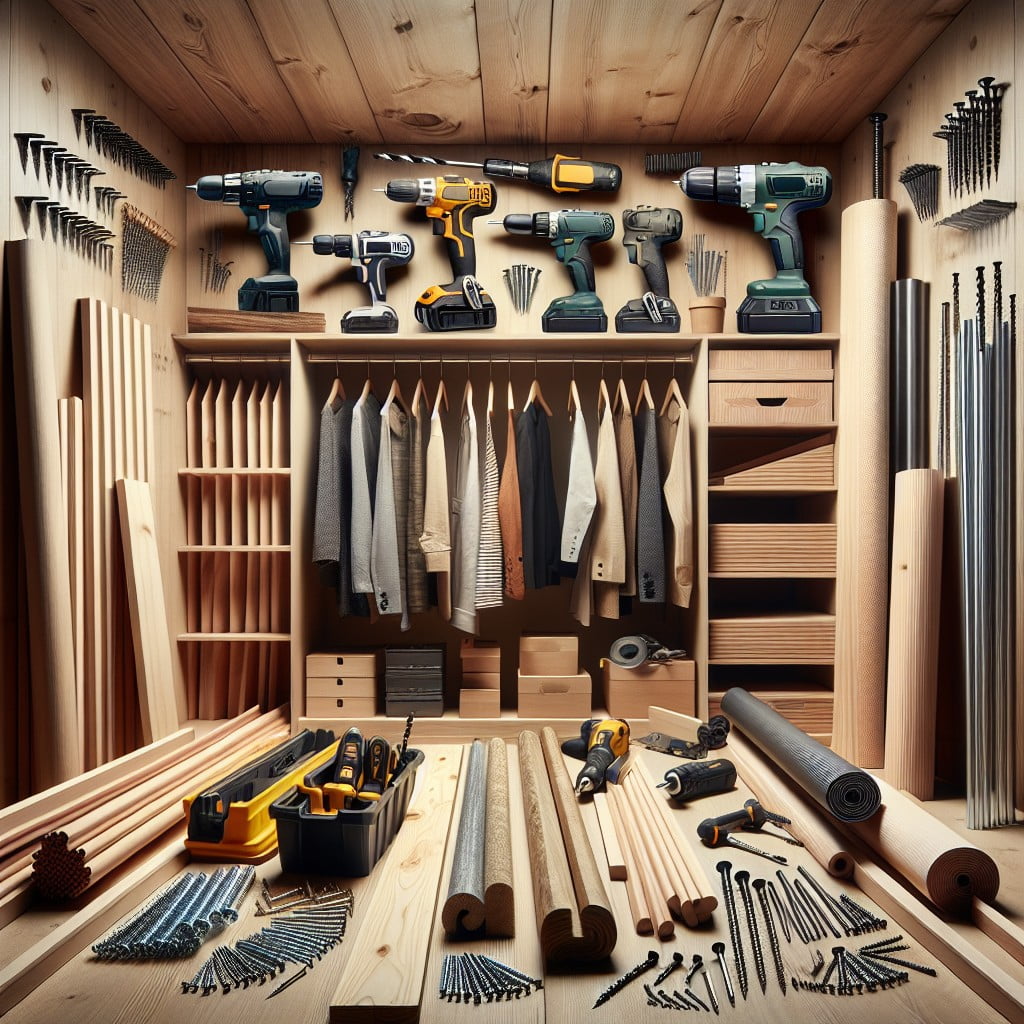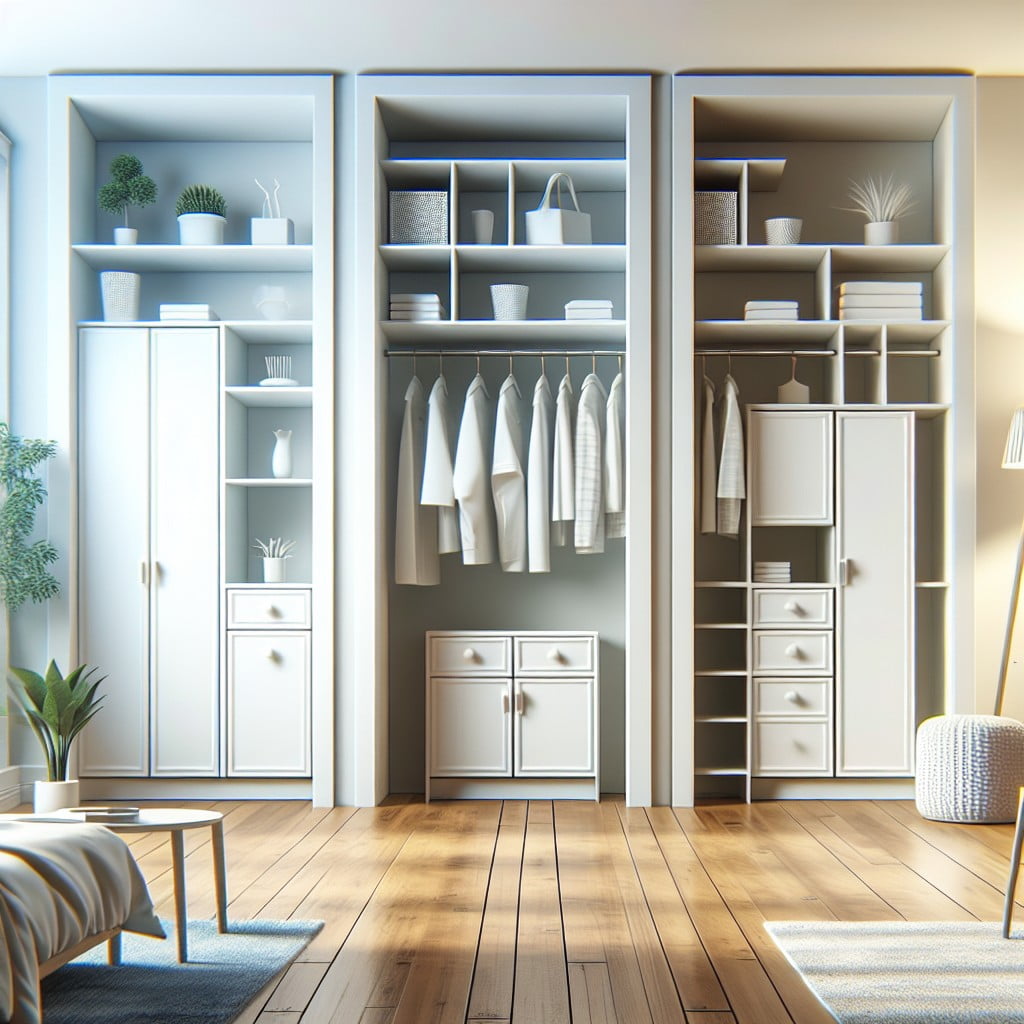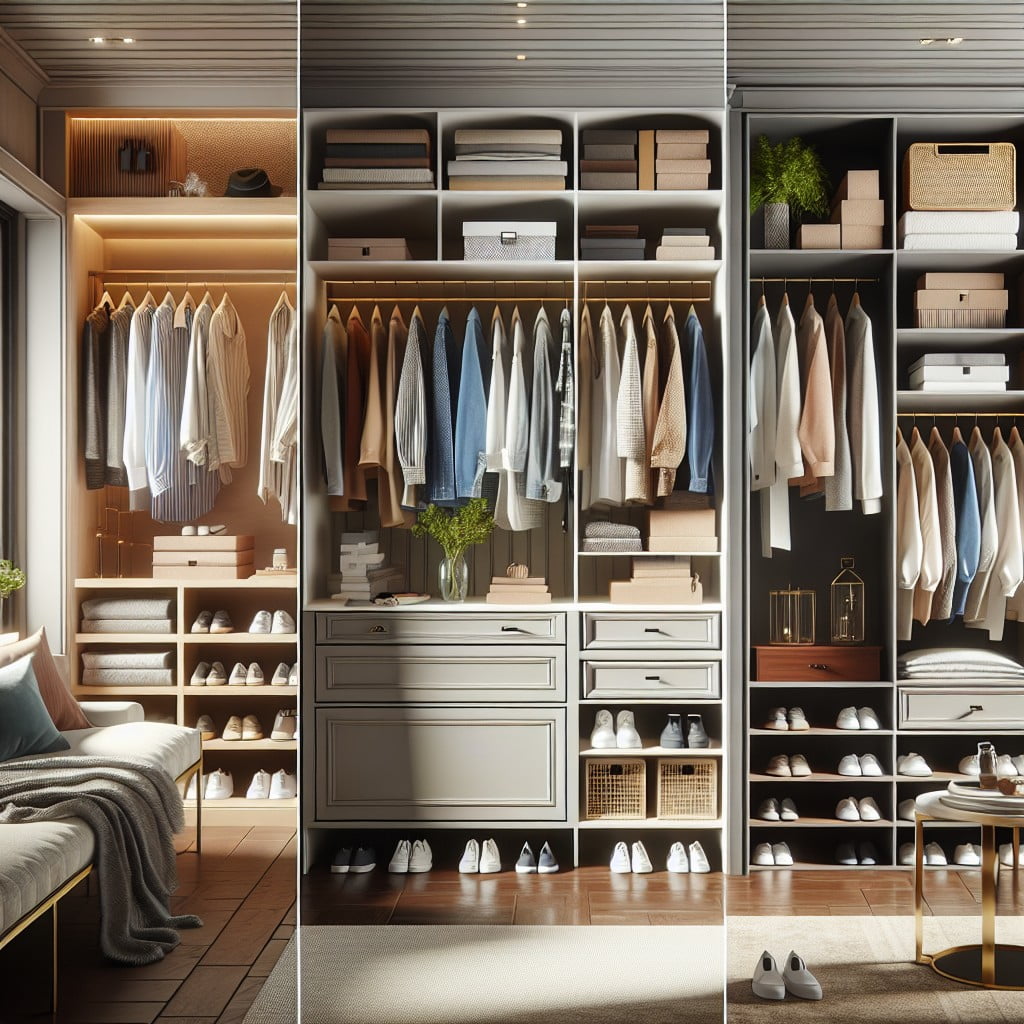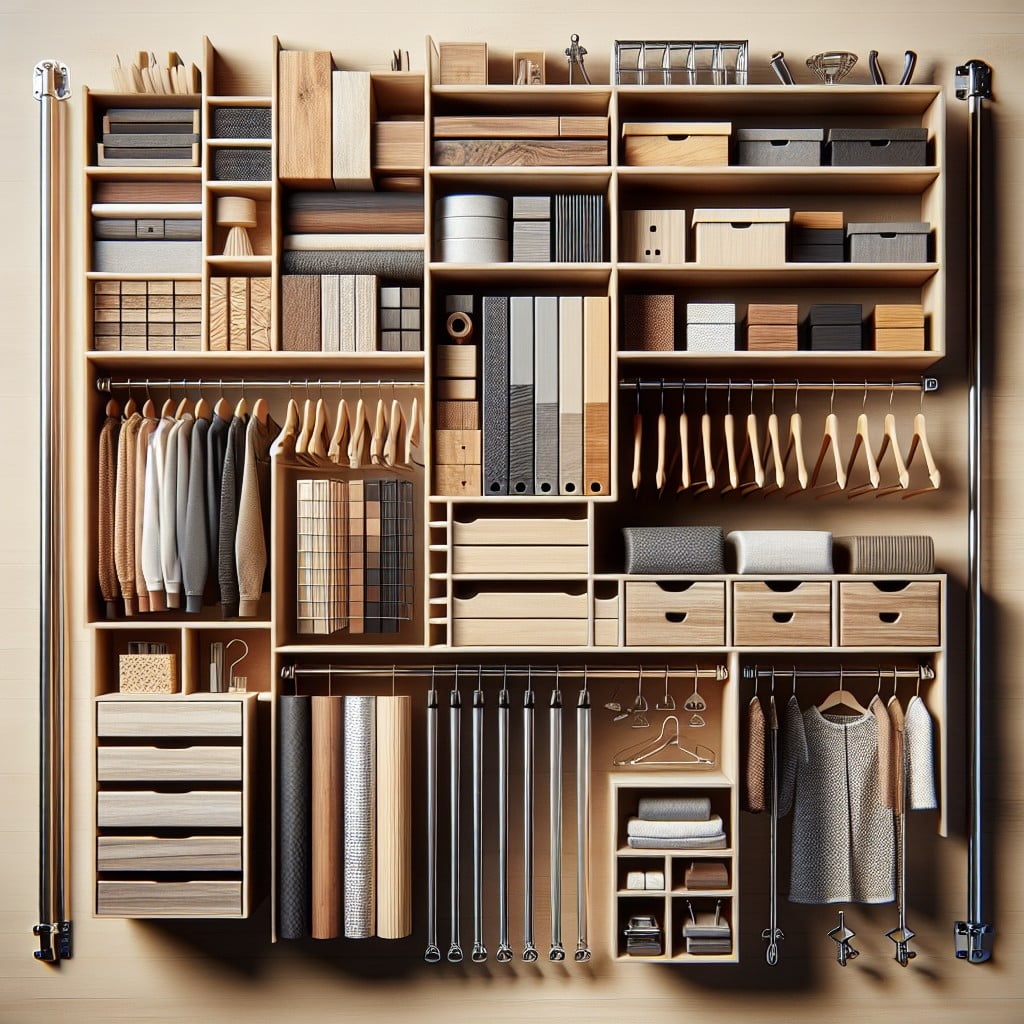Last updated on
Decoding the cost of your closet installation becomes essential because it helps plan your budget and ensure a seamless home improvement experience.
Key takeaways:
- Closet size greatly influences the final installation cost.
- Consider the complexity and configuration of your space.
- Material and accessory choices impact cost and longevity.
- Labor costs can vary based on geographic location.
- Walk-in, reach-in, and built-in closets offer different benefits and costs.
Factors in Calculating Custom Closet Cost

The dimensions of your space greatly influence the final bill. Essentially, larger closets require more materials and labor, hence a higher cost. The configuration, whether it’s a simpler reach-in or a more elaborate walk-in, also plays a part in pricing; more complex designs typically entail additional expense.
Materials are next on the list; high-end options like solid wood come at a premium, while laminate is more budget-friendly. Accessories, from drawers and shelves to specialized shoe racks and lighting, will augment both functionality and cost.
Don’t forget labor costs, which can fluctuate based on where you live. Metropolitan areas may have higher rates due to increased living costs. Every project is unique, so your location could either save you a few bucks or require you to budget a bit more.
Considering these factors early on helps in creating a realistic budget and gives you a clearer picture of where your money will be going.
Closet Size

Understanding how the size of your space impacts the overall cost is essential. Typically, costs are measured per square foot or linear foot. Smaller closets tend to incur lower expenses due to less material and labor. Conversely, large walk-in closets require more materials, like shelving units, and take longer to install, driving up the price.
Consider these points to gauge how size affects your budget:
- Measurement Accuracy: Precise dimensions guide the quantity of materials and the complexity of the project.
- Space Configuration: A simple layout may cost less than one with a complex design or odd angles.
- Expansion: Altering an existing space to create a larger closet might involve additional construction costs.
- Reconfiguration of Existing Space: Modifying an existing closet layout for improved functionality can impact the cost.
In summary, measure your space, consider complexity, and anticipate if expansions or alterations are needed to obtain an accurate installation estimate.
Closet Type

Walk-in closets are spacious and luxurious, allowing for clear visibility and organization of clothing and accessories. They often feature additional design elements such as seating or dressing areas and can range from modest to expansive sizes depending on the available space.
Reach-in closets are more common in smaller bedrooms or homes where space is limited. They are typically equipped with sliding or hinged doors, and their depth is usually sufficient for hangers and possibly a small set of drawers or shelves.
Built-in closets are customized to fit specific areas within a room, and their construction can involve intricate designs that match the room’s décor. These closets make efficient use of irregular spaces, such as under the stairs or in alcoves, maximizing storage capacity without occupying additional floor area.
Material choices, layouts, and accessories like rods, shelves, and drawers will ultimately determine the overall functionality and cost of these closet types. Each option can be tailored to individual storage needs and aesthetics, offering a range of possibilities for organization and style.
Material and Accessory Cost

Selecting the right materials and accessories can highly influence the overall cost of a closet installation. Plywood is a cost-effective option that provides durability, while solid wood offers a premium look and feel at a higher price point. Likewise, Melamine—an engineered wood—is both budget-friendly and available in a variety of finishes.
Accessories such as drawers, shelves, rods, and hooks add functionality to your closet but also add to the cost. Soft-close drawer slides and high-end pulls can elevate the finish but will reflect on the final bill. Deciding on accessories that balance functionality and cost is key to staying within budget without compromising on the usefulness of the space.
Investing in quality closet lighting is also advisable, although this may further increase the expense. LED lighting strips or puck lights enhance the closet’s functionality and aesthetic appeal but need to be planned for early in the design process.
Remember, the combination of materials and accessories doesn’t just influence the cost; it also impacts the longevity and satisfaction with your closet for years to come. Choose wisely to ensure a balance between aesthetics, functionality, and cost.
Labor and Geographic Location
Labor costs for closet installation can vary widely based on where you live. Typically, urban areas with a higher cost of living will also have higher rates for professional services, including closet installation. It’s not uncommon for labor charges to be billed per hour or as a flat fee per project.
Here are some quick points regarding how labor and location impact overall costs:
- Hourly Rates: Installation professionals generally charge between $50 to $100 per hour, depending on expertise and location.
- Per Project Rates: Some installers may provide a flat rate for the whole project, which can be economical for larger jobs.
- Regional Differences: Coastal cities and metropolitan areas tend to have higher labor rates compared to rural locations.
- Availability of Services: In areas with fewer service providers, prices may be higher due to less competition.
When budgeting for the installation, always consider getting multiple quotes to ensure competitive pricing and don’t hesitate to ask for a breakdown of labor costs versus material costs to understand where your money is going.
Custom Closet Types
Walk-in closets are the luxurious choice, providing ample room for storage and a dressing area. They’re often designed with a combination of hanging spaces, shelves, and drawers, and may even include a center island for additional counter space and storage.
Reach-in closets are more common, typically found in smaller bedrooms. These are characterized by a limited depth, but efficient organization can maximize the storage capacity of these spaces. The installation often involves a combination of hanging rods, shelves, and drawers.
Built-in closets are integrated into the room’s construction and offer a seamless look. They can be customized to fit any space, often utilizing unconventional areas like under the stairs. Options for built-in designs include adjustable shelving, hidden drawers, and specialty racks.
Each closet type offers unique benefits and can be tailored to suit individual storage needs and personal style preferences. The choice between them will significantly influence both the complexity of the installation process and the final cost.
Walk-In
A walk-in closet offers ample space, allowing for a more luxurious and personalized organizational layout. This option typically includes room for shelving, drawers, and sometimes even a dressing area.
The cost largely depends on the size and customization level; for instance, installing a basic system in a small space may start from $1,500, while a spacious, fully-customized walk-in closet can exceed $5,000. The inclusion of special features such as island dressers, elaborate shoe racks, or integrated lighting will add to the total cost.
When planning a walk-in, consider the balance between current needs and potential future requirements, as well as the return on investment in terms of property value.
Reach-In
Reach-in closets are typically less expansive than walk-ins but can be highly efficient with the right design. They are common in older homes and apartments, fitting flush against the wall and usually concealed by sliding doors or curtains. Their standard depth ranges from 24 to 30 inches and width can vary, making them suitable for bedrooms with limited space. The key to maximizing functionality in this type of closet is the intelligent use of organizers, such as drawer units, shelves, double hanging rods, and hooks.
Options like adjustable shelving or a custom layout can make the most of the vertical space, especially useful in children’s rooms for clothes they’ll grow into. Over-the-door storage solutions are also clever spaces to store shoes and accessories without compromising the interior space.
When seeking professional installation, the cost may be lower than that of a walk-in due to size and fewer complexities in design. However, adding high-end finishes, lighting, or specialized accessories can increase the price. It is crucial to prioritize needs over wants to manage expenses effectively while still achieving a practical and stylish storage space.
Built-In
Customizing your space with built-ins maximizes storage and introduces a seamless aesthetic. Unlike freestanding wardrobes or furniture, these units are tailored to fit your room’s specific dimensions, accommodating awkward corners or unique architectural features. They offer a variety of design options, from open shelving displaying curated accessories to hidden compartments for a minimalist look.
Opting for built-in closets means considering the room’s existing layout and how best to utilize the space. Typically, floor-to-ceiling designs make use of vertical areas. Lighting can also be integrated to illuminate your belongings and make selection a breeze. Finish and front choices—from mirrored doors to soft-close drawers—allow for personalization that reflects your style.
DIY Vs. Hiring a Professional for Closet Installation
Deciding whether to tackle a closet installation on your own or to bring in a professional hinges on several important considerations:
Skill Level and Experience:
DIY enthusiasts with a strong track record in home improvement projects may find closet installation a manageable challenge, provided they have the necessary tools and understanding of the task. If you’re new to such projects or uncomfortable with the required tools and techniques, professional installation will likely yield a more polished result.
Time Investment:
The DIY approach can be time-consuming. Evaluate if you have the leisure to dedicate to planning, measuring, purchasing materials, and the actual installation. Professionals can often complete the job faster due to their expertise and access to a team.
Tools and Equipment:
Professionals come equipped with all the necessary tools. DIY installers may need to purchase or rent tools, an additional cost to consider.
Cost Efficiency:
Initial appearances suggest that DIY saves money. However, mistakes can be costly. Professional services offer expertise but come at a higher upfront cost, which can be offset by efficiency and a more durable end product.
Quality and Longevity:
Professional installations often come with guarantees or warranties, assuring quality. While the DIY route can be rewarding, it may not always stand the test of time if craftsmanship is not up to par.
Permits and Codes:
For some closet installations, local building codes may require permits or inspections. Professionals are familiar with these regulations and can ensure that the installation is compliant.
When weighing options, assess the scope of your project against your capabilities and resources. A well-planned approach, be it DIY or professional, lays the foundation for a satisfying and functional closet installation.
FAQ
How much labor does it take to build a closet?
The construction of a custom closet typically requires labor hours priced between $50 and $100 each, exclusive of the design expenses that vary from $500 to $1000.
How much should I budget for custom closet?
For a standard walk-in closet, setting aside a budget between $2,000 and $5,000 should cover costs, with most individuals spending approximately $3,500; however, additional features and complex designs could increase the total expense.
Do closets add value to a home?
Yes, closets do add value to a home, with an average closet remodel yielding a return on investment of around 56%, increasing the home’s value by approximately $2,000.
What are the typical costs associated with walk-in closet installations?
The typical costs associated with walk-in closet installations range from $1,500 to $2,000 for a basic setup, while more luxurious designs can cost over $5,000.
Which factors influence the total cost of a closet remodel?
The total cost of a closet remodel is influenced by factors such as the size of the closet, the materials used, labor costs, and the complexity of the design.
How does the type of material chosen impact the cost of a closet installation?
The type of material chosen directly impacts the cost of a closet installation because high-quality, durable materials are typically more expensive than their cheaper, less robust counterparts.
Recap:




